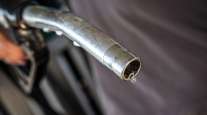Diesel Rises 5.4¢ to $3.069
This story appears in the April 19 print edition of Transport Topics.
The U.S. average retail diesel price rose another 5.4 cents a gallon last week to $3.069, raising concern among fleet executives and analysts alike that the steady rise could dampen economic growth.
The increase announced by the U.S. Department of Energy was the seventh in eight weeks, totaling 25.3 cents a gallon during that period. The gasoline average followed the same pattern, increasing 3.2 cents to $2.858 last week. It has risen 25 cents a gallon since Feb. 15.
In the past year, diesel has climbed 84 cents a gallon, or 38%, from $2.229 a gallon, while gasoline has risen 39% from $2.051 in the comparable week of last year.
“Fuel is going up and that’s not good not only for trucking; it’s also not good for the U.S. economy,” Don Hayden, president of M & M Cartage, Louisville, Ky., told Transport Topics. “If we start seeing all kinds of additional energy cost increases, that would set our economic recovery back.”
Hayden, whose dry van regional carrier has 140 trucks, said that “when [consumers] see fuel going up, that makes people nervous. That does not help consumer confidence.”
Phil Flynn, an oil analyst for PFG Best, agreed.
“There is no doubt that consumers are going have a hard time if gas prices go up more,” Flynn told TT. “A little inflation in oil prices is a good thing, but too much can kill you.”
“A rise in oil prices is good because it reflects better demand, but if they get too high, that can choke off growth,” he added.
Flynn said diesel could rise another 5 to 10 cents a gallon and peak around Memorial Day.
Martin Frisard, president of Frisard’s Trucking, Gramercy, La., already has felt the effects of fuel price increases this year, which have risen $15,000 a month so far.
“That’s certainly not good after what we went through in 2009,” he told TT. “What a rough year that was. Now, we are starting to come out of [recession] and here goes fuel again.”
Frisard’s, a truckload carrier with 50 units, added auxiliary power units five years ago, a move its president said was “a life saver.”
The company also has worked out fuel-purchase agreements with Travel Centers of America that have saved money. Frisard’s tells drivers to limit fuel purchases at other truck stops in order to reach a TA location where prices are lower, he said.
“We do have a fuel surcharge that helps,” Frisard said. “Kudos to the shippers. They understand what we are fighting; they are fighting the same thing — higher prices.”
“Last year, some shippers pretty much turned their back on their carriers,” he said. “Brokers were cutting rates by 5 cents or 10 cents a mile. Last year everyone was on scare alert and did what they had to do to stay open.”
Now, Frisard said, the situation is different.
“Shippers are realizing the first step they could have taken was to talk with their truckers,” he explained, as customers find that rising demand makes it more difficult to get trucks through brokers.
“Our philosophy is to try and develop the relationship with shippers for the good times and the bad times,” he said. “We are going to work together as a team so we can both stay in business.”
Both Frisard’s and M & M lowered speed limits, relying on that approach as a key method to control costs.
“We are going back and reminding everyone that fuel costs are going up and everyone needs to do everything they can to maximize fuel economy,” Hayden said.
The company is looking at other steps such as putting nitrogen instead of compressed air into tires, since academic and shipper studies have found savings with that approach.
M & M also is investigating trailer skirts that could save fuel in some markets, and it is looking into Schneider National’s savings from installing wheel covers made of fabric on tractors.
“Our eyes are open and our ears are listening for any technology or simple, common things to help increase fuel economy,” Hayden said.
By late last week, oil climbed to $85.51 a barrel on the New York Mercantile Exchange, after flirting with the $87 a barrel level for the first time since October 2008.
Federal Reserve Chairman Ben Bernanke recently signaled that the U.S. government is closely watching how oil price levels will affect the recovery.
In testimony before a congressional panel, Bernanke said higher fuel prices were “definitely a negative,” although he also observed that they are not a serious threat at the moment.
Also last week, the International Energy Agency’s monthly fuel market report said a continuing rise in oil prices could hurt worldwide economic expansion.




